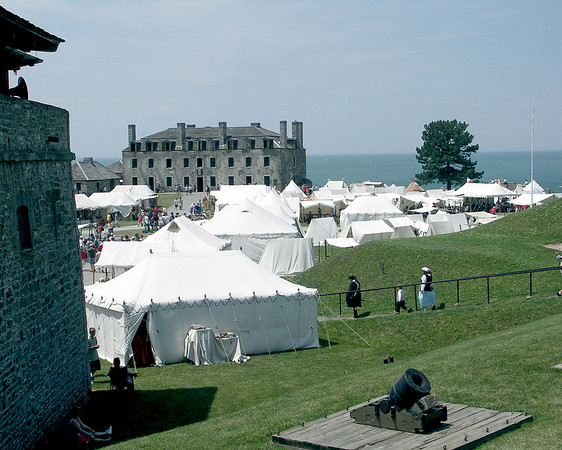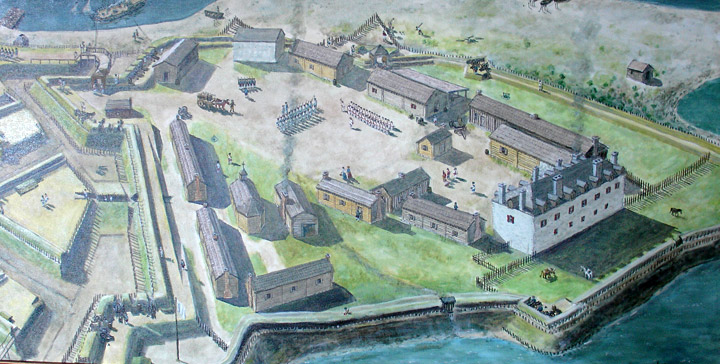Old Fort Niagara, considered gateway to the upper great lakes, has a rich history befitting a fortification that has stood since the early 1700’s. Over time, the fort has seen the ownership of three different nations during the period where control of the new world was contested by the European powers. And though the fort and its owner may have changed often during this period of its early history, its importance surely did not.
French Origins in Exploration
The new world and its woodland frontier, full of both recently discovered value such as furs for trade and land for expansion, as well as great further unknown potential, had European powers such as the French, British, and Spanish sending many people to colonize and explore. The French, in particular, spread out into the richly forested New world from the Great Lakes and Atlantic waterways along what is now the US-Canada border. But they would obviously need to create fortified positions, as there were already several different native peoples in these regions who could be friend or foe, as well as clashes with the expansion of the British, which began from the mid-Atlantic region of North America. These forts would have been placed in important locations and serve for a multitude of purposes.

Primarily, the French used the forts as a point where trade with the natives was conducted (likely for furs and such), or where goods obtained further inland would pass on their way to European markets. Orsamus H. Wilson once wrote of the Niagara river mouth area, “Here was the commencement of the portage around the Falls, where all the goods in process of transportation between the lakes underwent shipment.”[1], noting that the location was vital for keeping the trade goods flowing. A fortification in this place was therefore ideal for securing French presence in the area, but early forts on the site such as a Fort Denville did not fare well, and were abandoned. The successful attempt at establishing a permanent fort would occur in the later portion of the 1720s, with Fort Niagara being completed in 1727 on the east bank of the Niagara River’s outlet into lake Ontario. French general Marquis De Nonville had said since the 1690s that it was the best location on the entire lake, even though difficulties arose with transporting suitable lumber to the build site[1]. Around this period, tensions between the European colonial interests were growing, and it is noted that “During the colonial wars in North America a fort at the mouth of the Niagara River was vital, for it controlled access to the upper Great Lakes and the westward route to the heartland of the continent.” [2].
Upon the breakout of King George’s war between the French and British in 1744, the defensive role of Fort Niagara became immediately more significant, although its structure had declined somewhat, leading to the first major repair and expansion of the fort taking place[2]. The later French and Indian War saw another improvement and extension undertaken, with great earthworks added on so that it could repel the professional British armies. The fort also served the purpose as a staging point for raids and other attacks on the British by both French and Indian forces, a role it would reprise for the British during the Revolution and for the United States during the War of 1812 [2][3][4].
British Colonial Expansion
After the French and Indian War ended, the fort shifted into the control of the British, where “Niagara immediately became the guardian of Britain’s communications with West and provided a convenient storehouse for military supplies and trade goods consigned to the other Great Lakes forts” [2]. Instead of acting to secure the French’s dominant control of the Great Lakes region, it was now indispensable in the encroaching expansion of British influences. Neglected up-keeping during times of peace had again lead to the crumbling of the earthworks, so the defenses were improved again in 1768 with a stockade around the castle portion and two stone redoubts in 1770 and 71 (redoubts were additional defensive fortifications that were not directly joined to the main fort and typically lacked roofs, meant to keep initial fighting off of the fort itself [5]). By the American Revolution however, the fortifications had again become “little more than grass covered mounds outlined by sagging wooden pickets” [2]. The British therefore worked to re-fortify the fort once more. Thanks to its choice location, Fort Niagara “naturally became the headquarters of the bands of Indians and Tories who came down from Canada” [3] during the Revolution. In particular, a unit of loyalists turned raiders that fought with Iroquois Indians, known as Butler’s Rangers, used Niagara as their staging grounds [2]. The end of the Revolutionary War saw Fort Niagara just within the boundaries of the new nation, though it took over a decade for the garrisoning British troops to finally give up the fort.

American Border Fort
Under U.S. control, the role of the fortress now entailed the defense of a national border. In addition, the new garrison of the fort was used to assist the settlement of the New York side of the Niagara River, and to create a road for improved military access to the region. Efforts were made again to improve the artillery of the fort as to better exchange fire with Fort George, which the British had constructed on the opposite side of the river and still controlled. During the War of 1812, the fort was captured by an 1813 British offensive. They once again strengthened the deteriorated defenses and used the position to launch raids upon the U.S., and Fort Niagara was only returned to the U.S. after the war.
In 1816 plans for great improvements to the fortifications were created by U.S. army engineers, but little was actually completed, and the fort returned to the role of border post. The importance of Fort Niagara waned from here on, but many different roles and modern improvements were to be seen by the fort until the second half of the 1900s, when a large portion of the grounds were converted into a park.
Sources
Primary
- 1 Marshal, O. H. (pub. 1887) The Historical Writings of the Late Orsamus H. Marshal Relating to the Early History of the West. Library of Congress Digital Access. [1]
Secondary
- 1 Old Fort Niagara Association (n.d.). History of Old Fort Niagara. [2]
- 2 Maslowski, P. and Millet, A. R. (1994). For the Common Defense: A Military History of the United States of America (revised and expanded ed.). The Free Press. [4]
- 3 Thompson, J. M. (1907). “Fort Niagara as the Base of Indian and Tory Operations”. Proceedings of the New York Historical Association, vol. 7 (1907), pg 15-20. [3]
- 4 “The Fort of Four Nations”. Popular Mechanics, Dec. 1934, pg 867-869.
- 5 Fort Pitt Block House. (n.d.) What is a Redoubt?. [5]
Further Reading

